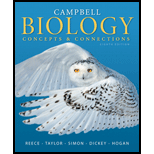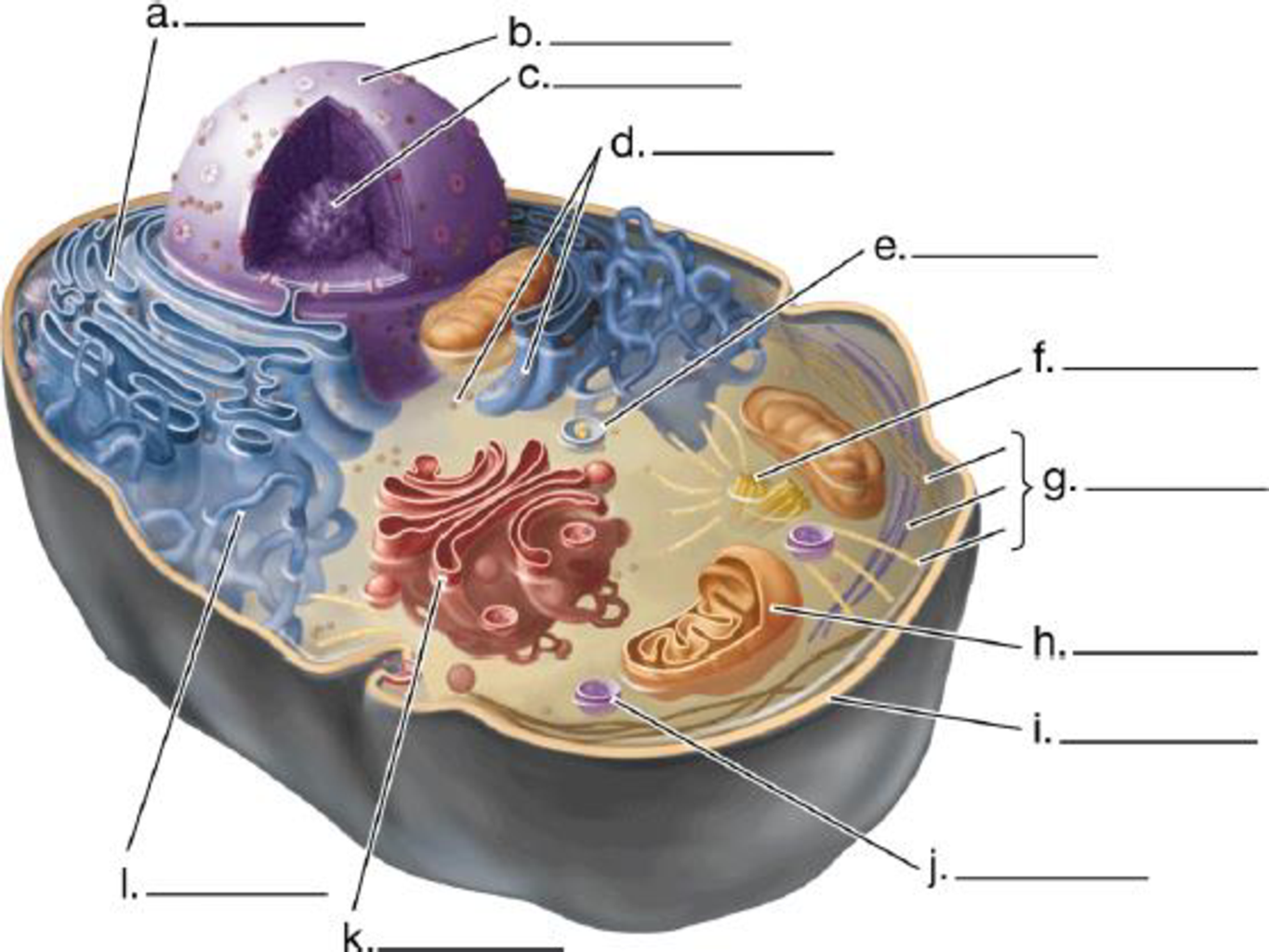
Campbell Biology: Concepts & Connections (8th Edition)
8th Edition
ISBN: 9780321885326
Author: Jane B. Reece, Martha R. Taylor, Eric J. Simon, Jean L. Dickey, Kelly A. Hogan
Publisher: PEARSON
expand_more
expand_more
format_list_bulleted
Concept explainers
Textbook Question
Chapter 4, Problem 1CC
Label the structures in this diagram of an animal cell. Review the functions of each of these organelles.

Expert Solution & Answer
Summary Introduction
To review: The structures and functions of each of the organelles in the given animal cell.
Introduction:
A cell is the fundamental structural and functional unit of living organisms. It is bounded by a cell membrane. Cells contain different organelles. Each organelle has its own specific features and functions. Each cellular organelle possesses different structural peculiarities.
Explanation of Solution
Pictorial representation:
Fig. 1 shows various structural organelles of an animal cell.

Fig. 1: Structure of an animal cell
The functions of various organelles are very specific.
- a. Rough ER: It is a network of membranous sacs and tubes; its external surface is attached with the ribosome. It helps in protein processing and secretion. Also, the addition of carbohydrate with protein occurs to produce glycoprotein, which helps in the production of a new membrane within the cell.
- b. Nucleus: It is a membrane-bound organelle covered by the nuclear envelope. The nucleus contains the nucleolus and chromatin material. The chromatin material consists of DNA and proteins.
- c. Nucleolus: It is a core region in the nucleus where components of the ribosome assemble.
- d. Ribosome: It is a non-membranous structure found in the cytoplasm of the cell. It is the core organelle for protein synthesis. It can be found free or attached with the rough endoplasmic reticulum.
- e. Peroxisome: It is a specialized single membrane–bound vesicle found in the cytoplasm of the cell. It produces hydrogen peroxide as a by-product and converts it to water.
- f. Centrosome: The formation of microtubules initiates at the centrosome. It contains a pair of centrioles.
- g. Cytoskeleton: It consists of a network of fibrous substances within the cytoplasm of a cell. The cytoskeleton consists of three main fibers called microtubules, microfilaments, and intermediate filaments. It helps in providing rigidity and gives structural support to the cell.
- h. Mitochondrion: It is double membrane–bound organelle. It is important for cellular respiration and energy generation in the form of ATP. The two phospholipid bilayer membranes enclosed with the mitochondria play a great role in functioning of mitochondria. It is also called as the “power house” of the cell.
- i. Plasma membrane: It is the protective compartment of the cell. It is composed of a lipid bilayer.
- j. Lysosome: It is a single membrane–bound organelle. It is the storage unit of hydrolytic enzymes. Breakdown of indigested substances takes place in lysosomes, and cell organelles are recycled here.
- k. Golgi apparatus: It is a single membrane–bound organelle stack of the flattened membranous sac. It is the active unit of modification, sorting, and secretion of cell products.
- l. Smooth ER: It is a network of membranous sacs and tubes but not attached with the ribosome. It helps in detoxification and lipid synthesis. It helps in folding of protein and transferring of the synthesized protein.
Want to see more full solutions like this?
Subscribe now to access step-by-step solutions to millions of textbook problems written by subject matter experts!
Students have asked these similar questions
what measures can a mother to take to improve the produce of her to milk to her newborn baby ?
1. Color the line that represents all ancestors of the Eastern white pine tree green (but only the ancestral line NOT shared with other organisms)
2. Oncle the last common ancestor of the Colorado blue spruce tree and Eastern white pine tree.
3. Put a box around the last common ancestor of the sugar maple tree and the dogwood tree.
4. Put a triangle around the last common ancestor of the red pine tree and the american holly bush.
5. Color the line that represents all ancestors of the Ponderosa pine tree red (including all shared ancestors).
6. Color the line that represents all ancestors of the American elm tree blue (including all shared ancestors).
7 Color the line that represents all ancestors of the Sabal palm tree purple (including all shared ancestors)
8. Using a yellow highlighter or colored pencil, circle the clade that includes all pine trees.
9. Using a orange highlighter or colored pencil, circle the clade that includes all gymnosperms
10. Can you tell…
You have been hired as a public relations specialist to give invertebrates a good name. After all, they are much more than just creepy crawly bugs!
Your first task though is to convince yourself that is true. The best way to do that is to start close to home. Find something in your house that is a product obtained directly from an invertebrate or only due to an invertebrate’s actions. Describe the product, its function and utility, as well as any human manufactured alternatives. Be sure to highlight the advantages of obtaining this directly from nature.
Keep in mind, a product can be something you use, wear, eat, or enjoy for its visual appeal.
Chapter 4 Solutions
Campbell Biology: Concepts & Connections (8th Edition)
Ch. 4 - Label the structures in this diagram of an animal...Ch. 4 - Prob. 2TYKCh. 4 - Prob. 3TYKCh. 4 - Which of the following clues would tell you...Ch. 4 - Prob. 5TYKCh. 4 - What four cellular components are shared by...Ch. 4 - Describe two different ways in which cilia can...Ch. 4 - In which cell would you find the most lysosomes?...Ch. 4 - Prob. 9TYKCh. 4 - Prob. 10TYK
Ch. 4 - In which cell would you find the most...Ch. 4 - In what ways do the internal membranes of a...Ch. 4 - Is this statement true or false? Animal cells have...Ch. 4 - Describe the structure of the plasma membrane of...Ch. 4 - Prob. 15TYKCh. 4 - Describe the pathway of the protein hormone...Ch. 4 - How might the phrase ingested but not digested be...Ch. 4 - Cilia are found on cells in almost every organ of...Ch. 4 - SCIENTIFIC THINKING Microtubules often produce...
Knowledge Booster
Learn more about
Need a deep-dive on the concept behind this application? Look no further. Learn more about this topic, biology and related others by exploring similar questions and additional content below.Similar questions
- Use the following tree diagram to answer Questions #8-10. 8) Which of the following two animals are the most closely related based on the tree to the left? a) Pig and camel b) Hippo and pig c) Deer and cow 9) CIRCLE on the tree diagram where the common ancestor between a hippo and a cow is. 10) Put a SQUARE on the tree diagram where the common ancestor between a pig and a peccary is.arrow_forwardExplain: Healthy Cell Function Overview→ Briefly describe how a healthy cell usually works: metabolism (ATP production), pH balance, glycogen storage, ion transport, enzymes, etc. Gene Mutation and Genetics Part→ Focus on the autosomal recessive mutation and explain: How gene mutation affects the cell. How autosomal inheritance works. Compare the normal and mutated gene sequences simply. → Talk about possible consequences of a faulty hydrolytic enzyme.arrow_forwardCan you fill out those termsarrow_forward
- Explain down bellow what happens to the cell: Decreased pH in mitochondria Increased ATP Decreased pH in cytosol Increased hydrolysis Decreasing glycogen and triglycerides Increased MAP kinase activity Poor ion transport → For each one:→ What normally happens?→ What is wrong now?→ How does it mess up the cell?arrow_forwardAn 1100 pound equine patient was given 20 mg/kg sucralfate 3 times a day, 2.8 mg/kg famotidine twice a day, and 10mg/kg doxycycline twice a day. Sucralfate comes as a 1 gm tablet, famotidine as 20 mg tablets, and doxycycline as 100mg tablets. All are in bottles of 100 tablets.How many total mg are needed for the patient and how many tablets of each would be needed to provide each dose?How many bottles of each would be needed to have available if this patient were to be on this drug regimen for 5 days?arrow_forwardThe patient needs a solution of 2.5% dextrose in Lactated Ringer’s solution to run at 75 ml/hr for at least the next 12hours. LRS comes in fluid bags of 500 ml, 1 Liter, 3 Liters and 5 Liters. How can a 2.5% solution be made by adding50% dextrose to the LRS?arrow_forward
- “Gretchen” was a 68-pound canine who came to the VMTH as small animal surgery patient. She receivedacepromazine, 0.2 mg/kg from a 10 mg/ml solution and oxymorphone, 0.08 mg/kg from a 1 mg/ml solution before surgery.What are the mechanisms of action of acepromazine and oxymorphone? Why would they be given together?How many mg provide each dose and how many ml of each of these solutions were given?arrow_forwardAfter surgery, “Gretchen” was put on carprofen, 1 mg/pound bid (twice a day). The tablets come in 25, 75 and 100 mgsizes. Which size tablet would be appropriate?What is the mechanism of action of carprofen?An outpatient prescription was written for her so she would have enough for 10 days. How many tablets did she need?What information needs to be on her out-patient prescription?arrow_forwardJoden Koepp olor in chickens is due to incomplete dominance. BB = Black chicken, WW = White BLOOD TYPES Arhite chicken is In humans, Rh positive blood is dominant (R) over Rh negative blood (r). A man with type 0, Rh positive blood (whose mother had Rh negative blood), marries a woman with type AB, Rh negative blood. Several children were born. is? R R Genotypes Phenotypes RRR RR Rr Rr 4/16 RR R RR RK Rr Rr 4/16 rr 3/4 Rh posi 1/4 Rh negu 1/2 Rr rr rr rrrr 88 888 75 e genotype of the man? the genotype of the woman? The mother of the man had type AB blood.arrow_forward
arrow_back_ios
SEE MORE QUESTIONS
arrow_forward_ios
Recommended textbooks for you
 Human Physiology: From Cells to Systems (MindTap ...BiologyISBN:9781285866932Author:Lauralee SherwoodPublisher:Cengage Learning
Human Physiology: From Cells to Systems (MindTap ...BiologyISBN:9781285866932Author:Lauralee SherwoodPublisher:Cengage Learning
 Biology Today and Tomorrow without Physiology (Mi...BiologyISBN:9781305117396Author:Cecie Starr, Christine Evers, Lisa StarrPublisher:Cengage Learning
Biology Today and Tomorrow without Physiology (Mi...BiologyISBN:9781305117396Author:Cecie Starr, Christine Evers, Lisa StarrPublisher:Cengage Learning


Human Physiology: From Cells to Systems (MindTap ...
Biology
ISBN:9781285866932
Author:Lauralee Sherwood
Publisher:Cengage Learning




Biology Today and Tomorrow without Physiology (Mi...
Biology
ISBN:9781305117396
Author:Cecie Starr, Christine Evers, Lisa Starr
Publisher:Cengage Learning
Dissection Basics | Types and Tools; Author: BlueLink: University of Michigan Anatomy;https://www.youtube.com/watch?v=-_B17pTmzto;License: Standard youtube license